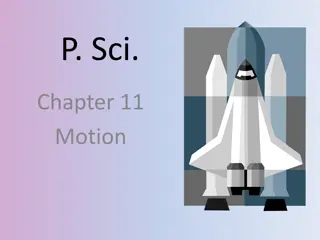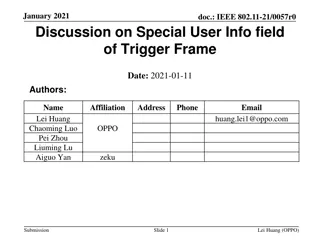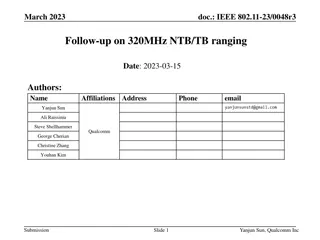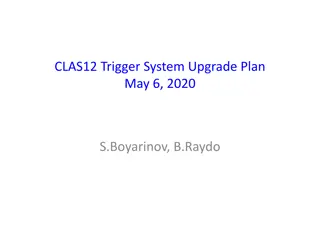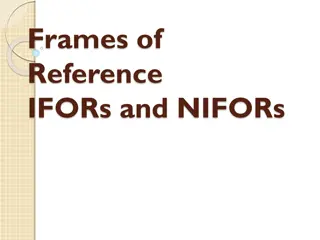IEEE 802.11-15/0880r2 Scheduled Trigger Frames - July 2015
This document from July 2015 discusses the IEEE 802.11-15/0880r2 Scheduled Trigger Frames, featuring various authors from Qualcomm, LG Electronics, Intel, Marvell, Broadcom, and Mediatek. The document includes multiple submission slides with contact information for the authors.
Download Presentation

Please find below an Image/Link to download the presentation.
The content on the website is provided AS IS for your information and personal use only. It may not be sold, licensed, or shared on other websites without obtaining consent from the author. Download presentation by click this link. If you encounter any issues during the download, it is possible that the publisher has removed the file from their server.
E N D
Presentation Transcript
July 2015 doc.: IEEE 802.11-15/0880r2 Scheduled Trigger frames Date: 2015-07-04 Authors: Name Affiliation Address Phone email Alfred Asterjadhi aasterja@qti.qualcomm.com 5775 Morehouse Dr. San Diego, CA, USA Simone Merlin smerlin@qti.qualcomm.com Bin Tian btian@qti.qualcomm.com 1700 Technology Drive San Jose, CA 95110, USA Carlos Aldana caldana@qca.qualcomm.com George Cherian gcherian@qti.qualcomm.com 5775 Morehouse Dr. San Diego, CA, USA Gwendolyn Barriac gbarriac@qti.qualcomm.com Hemanth Sampath hsampath@qti.qualcomm.com Menzo Wentink mwentink@qti.qualcomm.com Qualcomm Straatweg 66-S Breukelen, 3621 BR Netherlands Richard Van Nee rvannee@qti.qualcomm.com Albert Van Zelst allert@qti.qualcomm.com 1700 Technology Drive San Jose, CA 95110, USA 5775 Morehouse Dr. San Diego, CA, USA Rolf De Vegt rolfv@qca.qualcomm.com Sameer Vermani svverman@qti.qualcomm.com Tevfik Yucek tyucek@qca.qualcomm.com 1700 Technology Drive San Jose, CA 95110, USA VK Jones vkjones@qca.qualcomm.com Youhan Kim youhank@qca.qualcomm.com 1 Submission Slide 1 A. Asterjadhi, H. Choi, et. al.
July 2015 doc.: IEEE 802.11-15/0880r2 Authors (continued): Name Affiliation Address 19, Yangjae-daero 11gil, Seocho-gu, Seoul 137-130, Korea Phone email Kiseon Ryu kiseon.ryu@lge.com Hyeyouong Choi hy0117.choi@lge.com Jinyoung Chun jiny.chun@lge.com Jinsoo Choi js.choi@lge.com Jeongki Kim jeongki.kim@lge.com LG Electronics Giwon Park giwon.park@lge.com Dongguk Lim dongguk.lim@lge.com Suhwook Kim suhwook.kim@lge.com Eunsung Park esung.park@lge.com HanGyu Cho hg.cho@lge.com Jinmin Kim jinmin1230.kim@lge.com 2200 Mission College Blvd, Santa Clara, CA 95054 2111 NE 25th Ave, Hillsboro OR 97124, USA Shahrnaz Azizi shahrnaz.azizi@intel.com Eldad Perahia eldad.perahia@intel.com Robert Stacey +1-503-724-893 robert.stacey@intel.com Po-Kai Huang po-kai.huang@intel.com Intel Qinghua Li quinghua.li@intel.com Xiaogang Chen xiaogang.c.chen@intel.com Chittabrata Ghosh chittabrata.ghosh@intel.com Rongzhen Yang rongzhen.yang@intel.com Laurent cariou laurent.cariou@intel.com 1 Submission Slide 2 A. Asterjadhi, H. Choi, et. al.
July 2015 doc.: IEEE 802.11-15/0880r2 Authors (continued) Name Affiliation Address Phone email Ron Porat rporat@broadcom.com Matthew Fischer mfischer@broadcom.com Sriram Broadcom Venkateswaran Tu Nguyen Vinko Erceg 5488 Marvell Lane, Santa Clara, CA, 95054 Lei Wang 858-205-7286 Leileiw@marvell.com Hongyuan Zhang hongyuan@marvell.com Yakun Sun yakunsun@marvell.com Liwen Chu liwenchu@marvell.com Jinjing Jiang jinjing@marvell.com Marvell Yan Zhang yzhang@marvell.com Rui Cao ruicao@marvell.com Sudhir Srinivasa sudhirs@marvell.com Saga Tamhane sagar@marvell.com Mao Yu my@marvel..com Edward Au edwardau@marvell.com Hui-Ling Lu hlou@marvell.com Submission Slide 3 A. Asterjadhi, H. Choi, et. al.
July 2015 doc.: IEEE 802.11-15/0880r2 Authors (continued) Name Affiliation Address Phone email No. 1 Dusing 1st Road, Hsinchu, Taiwan James Yee +886-3-567-0766 james.yee@mediatek.com Alan Jauh alan.jauh@mediatek.com Mediatek Chingwa Hu chinghwa.yu@mediatek.com Frank Hsu frank.hsu@mediatek.com 2860 Junction Ave, San Jose, CA 95134, USA `Thomas Pare +1-408-526-1899 thomas.pare@mediatek.com chaochun.wang@mediatek.co m ChaoChun Wang James Wang james.wang@mediatek.com Mediatek USA Jianhan Liu Jianhan.Liu@mediatek.com Tianyu Wu tianyu.wu@mediatek.com Russell Huang russell.huang@mediatek.com ` Submission Slide 4 A. Asterjadhi, H. Choi, et. al.
July 2015 doc.: IEEE 802.11-15/0880r2 Authors (continued) Name Affiliation Address Phone email pbarber@broadbandmobilete ch.com Phillip Barber The Lone Star State, TX Peter Loc peterloc@iwirelesstech.com F1-17, Huawei Base, Bantian, Shenzhen 5B-N8, No.2222 Xinjinqiao Road, Pudong, Shanghai F1-17, Huawei Base, Bantian, Shenzhen 5B-N8, No.2222 Xinjinqiao Road, Pudong, Shanghai 5B-N8, No.2222 Xinjinqiao Road, Pudong, Shanghai 10180 Telesis Court, Suite 365, San Diego, CA 92121 NA 303 Terry Fox, Suite 400 Kanata, Ottawa, Canada F1-17, Huawei Base, Bantian, Shenzhen 10180 Telesis Court, Suite 365, San Diego, CA 92121 NA F1-17, Huawei Base, Bantian, SHenzhen 303 Terry Fox, Suite 400 Kanata, Ottawa, Canada 5B-N8, No.2222 Xinjinqiao Road, Pudong, Shanghai Le Liu +86-18601656691 liule@huawei.com Jun Luo jun.l@huawei.com Yi Luo +86-18665891036 Roy.luoyi@huawei.com Yingpei Lin linyingpei@huawei.com Jiyong Pang pangjiyong@huawei.com Huawei Zhigang Rong zhigang.rong@huawei.com Rob Sun Rob.Sun@huawei.com David X. Yang david.yangxun@huawei.com Yunsong Yang yangyunsong@huawei.com Zhou Lan +86-18565826350 Lanzhou1@huawei.com Junghoon Suh Junghoon.Suh@huawei.com Jiayin Zhang +86-18601656691 zhangjiayin@huawei.com Submission Slide 5 A. Asterjadhi, H. Choi, et. al.
July 2015 doc.: IEEE 802.11-15/0880r2 Authors (continued) Name Affiliation Address Phone email Thomas Derham Orange thomas.derham@orange.com 1-1 Hikari-no-oka, Yokosuka, Kanagawa 239-0847 Japan Yasushi Takatori takatori.yasushi@lab.ntt.co.jp Yasuhiko Inoue inoue.yasuhiko@lab.ntt.co.jp NTT Yusuke Asai asai.yusuke@lab.ntt.co.jp Koichi Ishihara ishihara.koichi@lab.ntt.co.jp Akira Kishida kishida.akira@lab.ntt.co.jp 3-6, Hikarinooka, Yokosuka- shi, Kanagawa, 239-8536, Japan yamadaakira@nttdocomo.co m Akira Yamada NTT 3240 Hillview Ave, Palo Alto, CA 94304 watanabe@docomoinnovatio ns.com DOCOMO Fujio Watanabe Haralabos Papadopoulos hpapadopoulos@docomoinno vations.com Innovation Park, Cambridge CB4 0DS (U.K.) Fei Tong +44 1223 434633 f.tong@samsung.com Maetan 3-dong; Yongtong-Gu Suwon; South Korea hyunjeong.kang@samsung.co m Hyunjeong Kang +82-31-279-9028 1301, E. Lookout Dr, Richardson TX 75070 Innovation Park, Cambridge CB4 0DS (U.K.) +44 1223 434600 1301, E. Lookout Dr, Richardson TX 75070 Kaushik Josiam (972) 761 7437 k.josiam@samsung.com Samsung Mark Rison m.rison@samsung.com Rakesh Taori (972) 761 7470 rakesh.taori@samsung.com Maetan 3-dong; Yongtong-Gu Suwon; South Korea +82-10-8864- 1751 Sanghyun Chang s29.chang@samsung.com Submission A. Asterjadhi, H. Choi, et. al. Slide 6
July 2015 doc.: IEEE 802.11-15/0880r2 Authors (continued) Name Affiliation Address Phone email #9 Wuxingduan, Xifeng Rd Xian, China Bo Sun sun.bo1@zte.com.cn Kaiying Lv lv.kaiying@zte.com.cn Yonggang Fang ZTE Ke Yao Weimin Xing 170 W Tasman Dr, San Jose, CA 95134 Brian Hart brianh@cisco.com Cisco Systems Pooya Monajemi pmonajem@cisco.com Joonsuk Kim joonsuk@apple.com Aon Mujtaba mujtaba@apple.com Guoqing Li Apple guoqing_li@apple.com Eric Wong ericwong@apple.com Chris Hartman chartman@apple.com Submission Slide 7 A. Asterjadhi, H. Choi, et. al.
July 2015 doc.: IEEE 802.11-15/0880r2 Introduction MU procedures are under discussion in 11ax The AP enables multiple STAs to transmit UL frames via Trigger frames (TFs) MU STAs wait for the TF prior to transmitting UL frames Upon reception of a TF intended to them they can transmit to the AP In this presentation we focus on trigger frame scheduling with TWT signaling [1] This way we also enable other useful operation modes for power save that fit in the 11ax use cases I.e., STAs wake up only in the allocated TWT SP and can sleep outside of them For simplicity, we focus on the implicit TWT operation which enables: Broadcast TWT: Scheduled by the AP, irrespective of TWT requests, and indicated in the Beacon for multiple STAs (a generic scheduling mechanism that covers operation in [1]) Solicited TWT: Scheduled by the AP, accounting for the STA s TWT request Submission Slide 8 A. Asterjadhi, H. Choi, et. al.
July 2015 doc.: IEEE 802.11-15/0880r2 Basics of Trigger TWTs Broadcast trigger TWT: AP indicates the target trigger times in a TWT response included in the Beacon The pattern can be periodic, aperiodic (i.e., single indication for multiple Trigger frames) The pattern is only valid for the Beacon Interval following the Beacon. The AP can indicate the broadcast trigger TWTs during a TWT Setup Next TWT TWT Wake Interval B e a c o n B e a c o n DL/UL MU DL/UL MU DL/UL MU DL/UL MU T F T F T F T F TWT element: Implicit TWT, Next TWT, TWT Wake Interval Solicited trigger TWT: A STA requests the AP to schedule TFs (using TWT request) TWT pattern is based on STA s UL traffic pattern and QoS requirements The pattern can be periodic or aperiodic The AP responds confirming or providing alternative TWT schedules The AP allocates its resources based on multiple STA s information STAs with similar traffic pattern can be allocated in similar TWTs, with similar TWT service periods (SPs), and other similar parameters Submission Slide 9 A. Asterjadhi, H. Choi, et. al.
July 2015 doc.: IEEE 802.11-15/0880r2 Solicited Trigger TWT TWT Wake Interval TWT Setup(s) Poll 1 BA 1 BA 2 BA 4 BU 1 BU 2 BU 4 A c k Tri gg er Next TWT(s) Tri gg er Poll 2 Poll 4 STA 1 STA 2 STA 4 TWT SP Trigger TWT setup (negotiated): Setup of TWT parameters is the same as for basic TWT operation with the following additions: The HE non-AP STA may request scheduling of a TF at the start of each TWT The AP confirms scheduling of a TF at the start of each TWT Trigger TWT operation: AP schedules a TF at the beginning of each TWT SP Non-AP STAs wake up at the TWT, wait for the TF and get ready for MU DL/UL exchange STAs are not supposed to contend during the TWT SP but rather wait for the TFs sent by the AP During the TWT SP, STAs can exchange PS-Polls, APSD trigger frames, UL/DL BUs, etc. upon reception of TFs. STAs that negotiate TWT need not wake up to read the Beacon frame DL BU availability is notified during the TWT SP itself. STAs can renegotiate their TWTs when a traffic pattern changes Submission Slide 10 A. Asterjadhi, H. Choi, et. al.
July 2015 doc.: IEEE 802.11-15/0880r2 Broadcast Trigger TWT (Target TBTT, Listen Interval) STA1, STA2 STA1, STA2 Target trans. Time 1 TIM Beac on TIM Beac on TIM Beac on DL MU Data TWT Res TF SIFS AP Awake State UL MU PS- Poll Listen Interval TWT Req SIFS Doze Doze Doze Doze STA1, STA2 Target TBTT TWT setup for broadcast trigger TWT TWT request/response can be exchanged by a STA and an AP to negotiate the target Beacon frame monitored by the PS STA. Example of operation A STA sends a TWT Request to request the broadcast trigger TWT operation. An AP sends a TWT Response including the Target Wake Time set to the target TBTT and TWT Wake Interval set to the ListenInterval of the STA. A STA monitors the Beacon frame with the period of TWT Wake Interval (ListenInterval) from the time of Target Wake Time (target TBTT). If a STA receives the target trigger times in a TWT response included in the Beacon, the STA may save its power till the time and the STA wakes up at the target trigger time to receive the Trigger frame. Otherwise, the STA save its power according to TWT Wake Interval. Note. It is applicable to PS STAs which should monitor the TIM Beacon frame with certain periodicity. Submission Slide 11 A. Asterjadhi, H. Choi, et. al.
July 2015 doc.: IEEE 802.11-15/0880r2 Benefits of TWTs TWT scheduling improves power saving for the SU case as exemplified in [1] It also eases contention as the STAs should not access the medium outside the TWT SPs For the MU case, the STA indicates/negotiates with the AP: The TWT SPs during which it is active and the rest of the times during which it is inactive Similar benefits to the SU case: STAs save power, eases channel contention, To send TFs at the start of the TWT SPs Enables MU operation during the TWT SP and protects the medium access for the STA Increases throughput as transmissions are protected at the receiver Increases network efficiency due to MU transmissions and reducing collisions The AP uses the TWT scheduling to: Spread out the wake up and access times of the STAs easing contention Allocate MU resources more efficiently (as it can be based on received feedback) Avoids allocating resources to STAs with no UL data Submission Slide 12 A. Asterjadhi, H. Choi, et. al.
July 2015 doc.: IEEE 802.11-15/0880r2 TWT element Target Wake Time TWT Group Assignment Nominal Minimum Wake Duration TWT Wake Interval Mantissa NDP Paging (optional) Element ID Request Type TWT Channel Length Control Octets: 1 1 1 2 8 or 0 9 or 3 or 0 1 2 1 0 or 4 B0 B1 B3 B4 B5 B6 B7 B9 B10 B14 B15 TWT Request TWT Setup Command Reserved Triggered TWT Flow Identifier Wake Interval Exponent Implicit Flow Type TWT Protection Bits: 1 3 1 1 1 3 5 1 Define a Triggered subfield in the Request Type field of the TWT element: Set to 1 in a TWT Request to request for a TF at the start of the TWT Set to 1 in a TWT Response to indicate that a TF will be scheduled at the start of the TWT Most of the use cases for 11ax seem to be covered by implicit TWT setup So suggestion is that for 11ax the Implicit field of the TWT element be set to 1 Some more evaluations are needed to understand the benefits of explicit TWT Which requires the use of TACK/STACK/BAT frames Hence, here we focus only on the implicit TWT Submission Slide 13 A. Asterjadhi, H. Choi, et. al.
July 2015 doc.: IEEE 802.11-15/0880r2 Summary of Trigger TWT Define implicit TWT operation for 11ax that enables: Solicited TWT: STA and the AP negotiate the TWT parameters STA sends TWT request and AP responds with a TWT response Broadcast TWT: AP indicates to STAs the TWT parameters AP sends TWT response to the STAs without receiving TWT requests The proposed Trigger TWT procedure Inherits the power saving properties of the TWT protocol [1] Submission Slide 14 A. Asterjadhi, H. Choi, et. al.
July 2015 doc.: IEEE 802.11-15/0880r2 Straw Poll #1 Do you support to add the following text in the SFD: The spec shall include a mechanism that allows a target transmission time for a Trigger frame to be indicated. The mechanism is based on implicit TWT operation and additionally enables: Broadcast triggered TWT by including a TWT element in the Beacon Solicited triggered TWT by using implicit TWT negotiation procedure Yes No Abstain Submission Slide 15 A. Asterjadhi, H. Choi, et. al.
July 2015 doc.: IEEE 802.11-15/0880r2 Straw Poll #2 Do you support to add the following text in the SFD: When the broadcast triggered TWT is enabled, STA and AP may exchange TWT request/response to indicate the target Beacon frame to be monitored by the PS STA. Yes No Abstain Submission Slide 16 A. Asterjadhi, H. Choi, et. al.
July 2015 doc.: IEEE 802.11-15/0880r2 References [1] M. Fischer (Broadcom) et. al., 11-12-0823-00-00ah-targetwaketime Submission Slide 17


